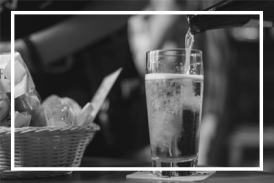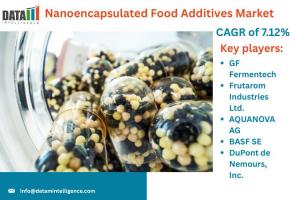Nanoencapsulated Food Additives Market Growth | Trends, Size, Share & Forecast 2025 | DataM Intelligence
The Nanoencapsulated Food Additives Market is expected to reach at a CAGR of 7.12% during the forecast period 2025-2032.
Market Overview:
Nanoencapsulation is the process of enclosing active compounds like vitamins, antioxidants, and probiotics into nanoscale carriers to improve their stability, bioavailability, and controlled release. This technology is transforming the food sector by enhancing nutrition delivery and extending shelf life, in line with the growing customer demand for health-promoting foods.
Download Sample Report Here: https://www.datamintelligence.com/download-sample/nanoencapsulated-food-additives-market
Market Drivers and Opportunities:
Key factors driving the market include:
Enhanced Nutrient Delivery: Nanoencapsulation increases the absorption and storage of bioactive chemicals, resulting in more effective delivery in functional meals.
Rising Health Consciousness: Consumers are increasingly looking for foods that provide extra health benefits, such as immune-boosting additives and gut-health boosters.
Technological Advancements: Innovations in nanotechnology are enabling the development of more efficient and sustainable encapsulation methods.
Opportunities lie in expanding applications across various food segments, including beverages, dairy products, and snacks, as well as exploring biodegradable and sustainable encapsulation materials.
Market Segmentation:
By Additive Type:
Flavors
Vitamins and Minerals
Antioxidants
Antimicrobials
Others.
By Encapsulation Technique:
Lipid-based Nanoencapsulation
Polymeric Nanoencapsulation
Polysaccharide-based Nanoencapsulation
Others.
By Application:
Beverages
Dairy & Frozen Desserts
Bakery & Confectionery
Processed Foods
Others.
By Region:
North America
Latin America
Europe
Asia Pacific
Middle East and Africa.
Regional Market Share:
North America: The largest market share, driven by strong R&D investments and high consumer awareness.
Asia-Pacific: The fastest-growing region, with significant contributions from countries like Japan and India, due to expanding food industries and increasing health consciousness .
Europe: Notable growth, supported by stringent food safety regulations and a focus on clean-label products.
Key Market Players:
The top companies in the nanoencapsulated food additives market include:
GF Fermentech
Frutarom Industries Ltd.
AQUANOVA AG
BASF SE
DuPont de Nemours, Inc.
To increase their market position, these organizations prioritize product innovation and strategic collaborations.
Recent Developments:
United States:
December 2024: BASF SE introduced a novel polymeric nanoencapsulation solution to improve the stability and release patterns of active substances in beverages and functional meals.
November 2024: Nestlé S.A. introduces a line of nanoencapsulated vitamins to its dairy products, improving nutrient absorption for consumers.
Japan:
April 2025: A Japanese food technology startup unveiled a novel lipid-based nanoencapsulation system aimed at improving the shelf life and flavor stability of traditional fermented foods.
February 2025: Researchers at a Japanese university developed a biodegradable nanoencapsulation material derived from seaweed, offering an eco-friendly alternative for food applications.
Stay informed with the latest industry insights-start your subscription now: https://www.datamintelligence.com/reports-subscription
Conclusion:
The market for nanoencapsulated food additives is expected to increase significantly, driven by technical advancements and rising consumer demand for functional foods. Companies who invest in R&D and sustainable practices will be well-positioned to capitalize on new opportunities in this dynamic market.
Related Reports:
Pet Food Additives Market
Food Encapsulation Market
Sai Kiran
DataM Intelligence 4Market Research
+1 877-441-4866
Sai.k@datamintelligence.com
Visit us on social media:
LinkedIn
X
Legal Disclaimer:
EIN Presswire provides this news content "as is" without warranty of any kind. We do not accept any responsibility or liability for the accuracy, content, images, videos, licenses, completeness, legality, or reliability of the information contained in this article. If you have any complaints or copyright issues related to this article, kindly contact the author above.
Car Lube Container Market to Hit USD 8.4 billion by 2035, Driving Solutions for Auto Packaging
Oil Mill Machine Market Forecast Outlook 2025 to 2035 Driven by Automation, Efficiency, and Growing Edible Oil Demand
Microcontroller Market Growth Accelerates as Demand Surges Across Key Industries
Więcej ważnych informacji
 Jedynka Newserii
Jedynka Newserii

 Jedynka Newserii
Jedynka Newserii

Konsument

Wzrost sprzedaży piw bezalkoholowych idzie w parze z inwestycjami w zieloną energię. Kompania Piwowarska ogranicza ślad węglowy i wspiera lokalne inicjatywy
Kompania Piwowarska kontynuuję realizację strategii „Lepsza Przyszłość 2030”, w której łączy ambitne cele środowiskowe, edukacja konsumentów oraz rozwój segmentu piw bezalkoholowych z realnym wsparciem dla lokalnych społeczności. Firma, będąca liderem polskiego rynku piwa, ogranicza emisję CO₂, zwiększa udział opakowań zwrotnych i angażuje pracowników w wolontariat, w tym m.in. w pomoc dla ofiar powodzi na Dolnym Śląsku.
Handel
D. Joński: Europa musi chronić swój rynek poprzez cła i wysokie standardy bezpieczeństwa dla importowanych towarów. Powinniśmy budować własny przemysł oparty na tańszej energii

Tańsza energia, a przez to niższe koszty produkcji w Europie to jeden z kierunków, który wskazuje Unia Europejska w rywalizacji z tanimi towarami z Azji, głównie z Chin. Jednocześnie rynek Starego Kontynentu powinien być chroniony poprzez zbalansowane cła oraz wysokie standardy bezpieczeństwa stawiane importowanym produktom. Zdaniem europosła Dariusza Jońskiego ważne jest rozwijanie przemysłu w Europie bez względu na narodowość właścicieli. Relacje z Chinami muszą zostać na nowo zdefiniowane i przebiegać na równych zasadach.
Handel
Poprawia się jakość raportów dużych spółek giełdowych dotyczących zrównoważonego rozwoju. Pozostają też obszary do dopracowania

Ekspertki i eksperci z Deloitte’a przeprowadzili analizę ujawnień taksonomicznych spółek notowanych na Giełdzie Papierów Wartościowych, która objęła sprawozdania z działalności za rok 2024 w części dotyczącej zrównoważonego rozwoju. To trzeci rok ujawniania stopnia zgodności przedsiębiorstw z Taksonomią Unii Europejskiej, co przekłada się na zwiększoną jakość i porównywalność prezentowanych danych. Jednocześnie można oczekiwać, że inwestycje zgodne z Taksonomią będą coraz istotniejszym elementem strategii rozwoju przedsiębiorstw w kolejnych latach.
Partner serwisu
Szkolenia

Akademia Newserii
Akademia Newserii to projekt, w ramach którego najlepsi polscy dziennikarze biznesowi, giełdowi oraz lifestylowi, a także szkoleniowcy z wieloletnim doświadczeniem dzielą się swoją wiedzą nt. pracy z mediami.









.gif)

 |
| |
| |
|